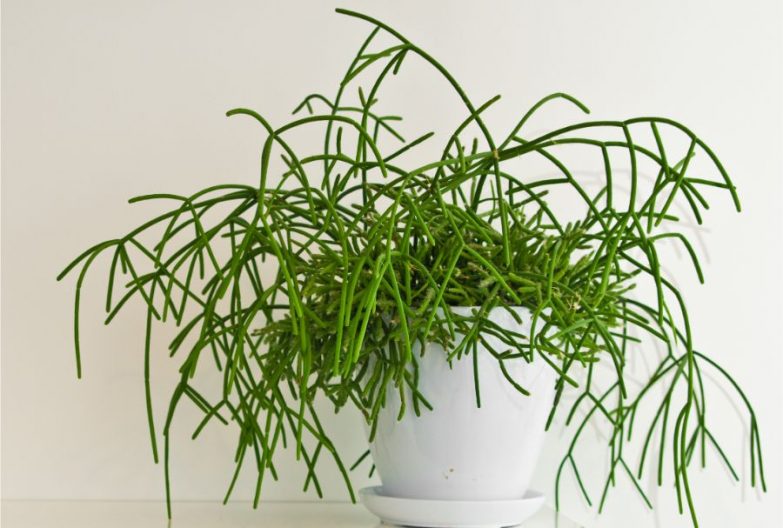Rhipsalis are tropical plants in the cactus family with long, trailing stems making them perfect choices as indoor hanging plants. Aside from the attractive foliage, they also offer the added bonus of almost year-round blooms and fruit. This article will cover everything you need to know about rhipsalis care, but let’s start with a quick summary.
Rhipsalis care summary: Grow in rich, well-draining soil, create a humid environment and water when the soil surface starts to dry. Situate in bright but filtered light, in a site with temperatures averaging between 60°F to 80°F and fertilize monthly during the growing season.
Read on and we’ll go into the detail of rhipsalis care to ensure you keep your mistletoe cactus thriving for years to come.
Rhipsalis Care – How To Grow Mistletoe Cactus
Rhipsalis is a genus made up of 35 different species and belongs in the same family as other types of cacti. The name Rhipsalis is often used interchangeably with the common name, Mistletoe Cactus.
Some Rhipsalis species, including Rhipsalis baccifera, Rhipsalis cassutha and Rhipsalis burchelli produce small, white cylindrical fruits after the blooms fade, which look visually similar to mistletoe, hence the name.
Not all species within the Rhipsalis genus produce these characteristic white fruits, but many people use Rhipsalis and Mistletoe Cactus as synonyms, and so shall I in this article.
If the attractive looks weren’t enough, the fruits are edible and said to have a soft sweet taste. Therefore, you get the added bonus of having a showy houseplant that also produces edible fruits.
Rhipsalis are unusual in that they aren’t native to hot and dry desert regions of the world. They differ in that they prefer a warm but humid environment and lower light conditions.
It’s native range includes the tropical and subtropical rainforest and coastal regions of Florida, the Caribbean, South and Central America, along with tropical regions of Africa stretching into Sri Lanka.
Rhipsalis hold the honor of being the only cactus type that occurs naturally outside of the New World. One thought is migratory birds introduced the Rhipsalis species to the Old World long enough ago that it’s considered a distinct subspecies.
Rhipsalis Characteristics
Like its other relatives, Rhipsalis are considered epiphytes, meaning they grow attached to branches or on the trunks of trees. Additionally, of all the types of cacti, Rhipsalis is the most widespread.
The thread-like succulent stems on the cactus are narrow, green and in their native habitat can grow up to 30 feet long. However, when grown indoors, the stems typically only grow about half that length. The multitude of thin stems the cactus produces makes Mistletoe Cactus plants thick and bushy eye-catching specimens wherever placed indoors.
Mistletoe Cactus’ thread-like, succulent stems and bunching habit makes it look very similar to another succulent, Pencil Cactus (Euphorbia tirucalli). However, and unlike Mistletoe Cactus, Pencil Cactus are not cactus and have a tree-like habit, growing up to the ceiling even indoors.
Unlike other flowering epiphyte cacti like Christmas Cactus, which produces large flowers, Mistletoe Cactus produces tiny greenish-white blooms starting in spring and blooming periodically throughout the year.
Rhipsalis Care Summary
| Scientific Name | Rhipsalis spp |
| Origin | Florida, The Caribbean, South and Central America, Africa |
| Light Requirements | Bright, indirect light. Avoid direct sunlight. |
| Watering | Water once the surface of the soil is dry during the growing season. Maintain lightly moist soil. Reduce watering in winter. |
| Soil | Well-draining, rich and slightly acidic soil mixture |
| Temperature | 60-80°F (16-27°C). Not frost resistant. |
| Fertilizer | Fertilize monthly during the growing season. I use this water soluble fertilizer at half strength. |
| Humidity | Moderate to high humidity. |
| Flowering | Pale white flowers, followed by small, white cylindrical fruits. |
| Pruning | Prune to maintain size and remove dead foliage. |
| Propagation | Best propagated by stem cutting during periods of active growth. |
| Re-Potting | Repot every few years to refresh soil or increase pot size as your Rhipsalis grows. |
| Diseases and Pests | Overwatering can result in root rot. Mealybugs are the most common pests. |
| Toxicity | Non-toxic to humans and animals. |
| Where To Buy | Buy a Rhipsalis online at Etsy (I buy most of my houseplants from Etsy). |
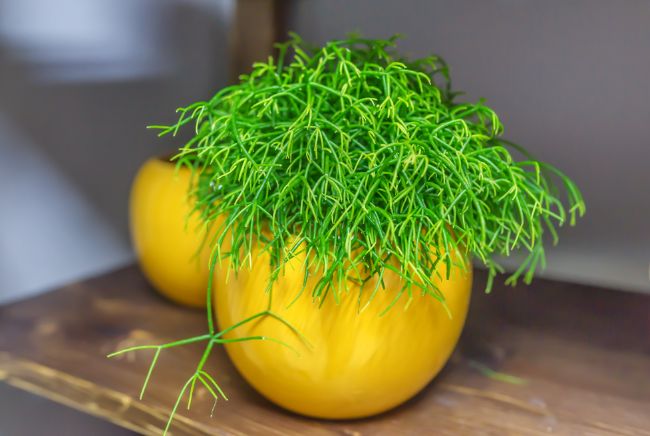
Rhipsalis Soil Requirements
Good Rhipsalis care starts with choosing the right soil for your plant. Unlike most species of cactus, Mistletoe Cactus will grow best in a well-drained, rich, and slightly acidic soil mixture and not in a cactus mix, which is more lightweight and doesn’t contain the same amount of nutrients.
Although it prefers moist soil, it won’t tolerate soggy soil, and prolonged waterlogged conditions will result in root rot and plant death.
Many types of commercial potting mixes will work well to plant and grow rhipsalis, as they drain well and contain the desired amount of nutrients for good growth. However, you can easily make your own soil mixture and some mixture suggestions include:
- One part peat, one part sterile sand and one part potting soil.
- One part peat, one part compost and one part sterile sand.
- One part sphagnum moss, one part potting mix and one part perlite.
Whatever types of soil mix you decide to use just make sure it drains well. It’s easy to tell if your soil mix is too heavy. If after watering the water takes quite a while to drain from the top, your soil mixture is too heavy and needs lightening.
Light Requirements
Rhipsalis care is different from other types of cactus in that it doesn’t like to be situated in direct full sunlight. Too much sun can burn the thread-like stems, turning them a reddish color and they will take on a wilted look.
Place your Mistletoe Cactus in a location that receives bright but filtered light. Placing it either in or near an east-facing window gives the cactus a sufficient amount of light. West-facing windows also work well provided the plant receives filtered light through a curtain or window shade.
Your cactus might not receive enough light grown in a north-facing window and unless shaded by a window treatment, a south-facing window is usually too bright. If you decide to give your Mistletoe Cactus a break from its indoor home once the weather warms in springtime, place in a shady location to prevent burning.
Temperature Requirements
Don’t forget that Rhipsalis plants call consistently warm and humid subtropical and tropical locations home. Therefore, when grown indoors, don’t situate the cactus in cold or drafty rooms. Excessively cold conditions can negatively affect your rhipsalis and possibly kill it.
Additionally, you don’t want to place your Rhipsalis near a heating vent that is too drying for this humidity lover. To provide good rhipsalis care, place your Mistletoe Cactus in an indoor location where temperatures range between 60°F and 80°F.
Mistletoe cactus will bloom regularly when placed in an indoor site where the temperatures are steady. Once it produces its flower buds do not relocated the cactus or you risk all the blossoms dropping from the plant.
In spring and summer when outdoor temperatures have warmed, you can give your Mistletoe Cactus a break from indoors by placing it in a shady location outside. Just be sure to bring it back inside to its protected location before winter comes around.
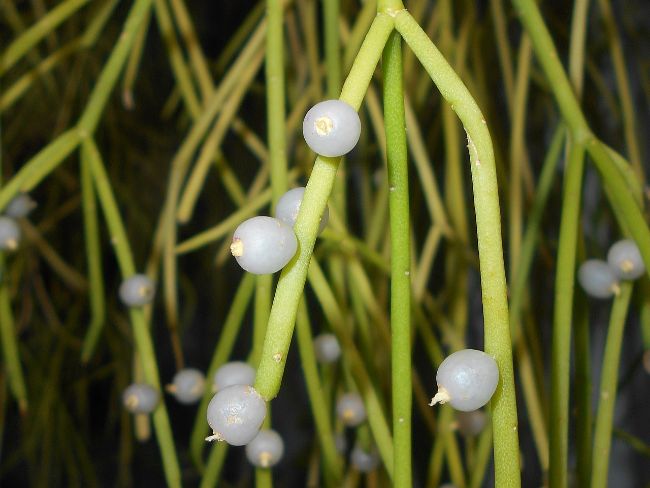
Water Requirements
Compared to other cactus types, Rhipsalis is thirstier and prefers more frequent watering and slightly moist soil to grow best. However, if you occasionally forget to water your Rhipsalis, it is forgiving and tolerates short periods of drought. Below are the best practices for seasonal watering.
- Spring through Summer: This is considered the growing season, so plan to water your Mistletoe Cactus every time the surface of the soil dries out.
- Fall and Winter: During the cold seasons of fall and winter, your Mistletoe Cactus goes through dormancy and growth slows. Allow the top few inches of soil to dry out before watering. You may only need to water every couple of weeks.
Checking to see if it’s time to water your Mistletoe Cactus is easy. Just feel the top of the soil and if it’s starting to become dry, give the cactus a drink of water.
Additionally, you should avoid soggy conditions or it will develop rot and die. If you notice the stems dropping, turning black or wilting, check the moisture in the soil. Ensure the soil and pot drain well and take care not to water too frequently. Follow the advice in this article if you think you may be overwatering your rhipsalis.
On the other hand, your Mistletoe Cactus won’t tolerate long periods without a drink, especially during the growing season. If the stems start looking puckered, you’re under-watering and the Rhipsalis needs a good drink.
Always use room temperature water and when it comes to the type of water that’s best for your Mistletoe cactus, use one of the following:
- Rainwater
- Distilled water
- Tap water that’s been allowed to sit out overnight
Humidity Requirements
Another characteristic that makes Rhipsalis care differ from the vast majority of other cactus species is its need for humidity. Remember, Rhipsalis is native to subtropical and tropical regions that are constantly humid. A lack of humidity causes problems with growth and appearance.
Don’t think that creating humidity around your cactus is difficult or requires a science degree, because you have various options that fulfil the plant’s needs, and gives it the humid conditions it desire.
- Depending on the type of container used, you can group several plants around the Mistletoe cactus to create humidity. Of course, if it’s growing in a hanging basket this might be a bit harder unless you can hang several other plants around the cactus.
- Place the cactus in a room that produces humidity naturally. If you have room and adequate light inside a bathroom or kitchen where water is constantly used, you can grow the cactus there.
- If you are growing the cactus in a standing container and not a hanging basket, you can place the container on a tray of pebbles that collects water as the container drains. As the water evaporates, humidity is created.
Read more about how to increase humidity for your indoor plants in this article.
Fertilizer Needs
To keep your Mistletoe cactus looking and performing at its best, it requires periodic feedings throughout the growing seasons of spring through summer. Feed monthly during spring and summer with a water-soluble blend for houseplants. Stop feeding in winter.
When it comes to feeding your cactus, more fertilizer is not better than using less and can create problems. The included salts in the fertilizer can cause the stems to look brown and burnt. For this reason, I tend to make fertilizer up at half strength, to reduce the risk of problems.
Learn more about how to fertilize your houseplants here.
Periodic flushing of the soil is suggested to remove any buildup of salts from the fertilizer contained in the soil. About every six months, you can flush the soil to remove the salts and the process is simple.
- Take the container to the sink or bathtub and allow the water to run gently through the container’s soil for about five minutes. Allow the water to drain, empty the catch tray and place your Rhipsalis back where it’s growing.
Of course, if your plant is too large to flush indoors, you can take it outside to the hose and gently flush.
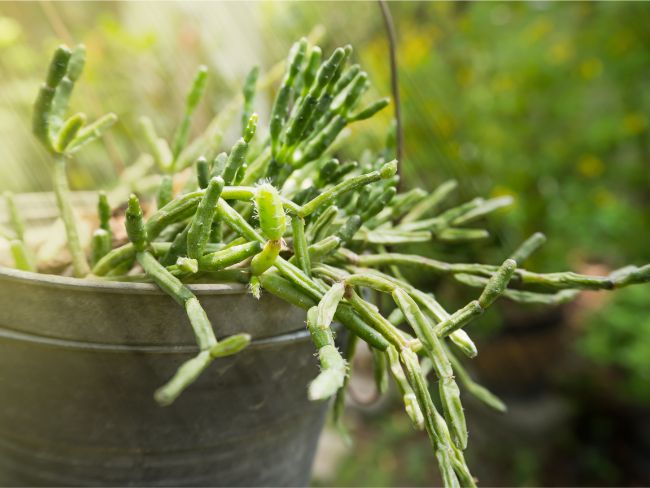
Pruning Needs
Pruning needs for a Mistletoe Cactus are very low. About the only time you will find yourself needing to give the cactus a trim is if you find broken stems or if the plant is getting a little too large for your liking.
To keep from spreading unwanted diseases and pests to your Rhipsalis, always use sterilized pruning tools. You can easily clean the tool’s blades by wiping them off with rubbing alcohol before you start trimming.
Planting Tips For Good Rhipsalis Care
Your Rhipsalis should grow well for quite some time in its present container and you will only have to repot every few years to refresh the soil or plant in a larger container, if it’s outgrown its present one.
However, if you need to repot, the steps are relatively basic.
- Select a draining container that is one size larger than the original one, if your Mistletoe Cactus has outgrown its present container.
- Fill the container about a quarter full of a rich, well-drained potting mix. Water the soil so it settles.
- Gently remove the Mistletoe Cactus from its original container, being careful not to break the succulent stems. If needed, gently tease the roots apart.
- Place the cactus in its new container and fill the remainder of the container with soil. Using your hands, gently firm the soil around the cactus.
- Water the cactus again and until it runs from the bottom drain holes. Place the container in a suitable indoor location or where it was originally growing.
These planting tips also work well if you are propagating new Rhipsalis plants.
Propagating Rhipsalis
Another bonus to growing Rhipsalis is the ease new plants are propagated. Using clean pruning tools simply snip off a section of stem and plant in a container. For the best success, propagate new plants during the growing season of spring through summer.
Successful propagation tips include:
- Use a container with bottom drain holes filled with a rich, well-drained potting mix.
- Bury the cut end of the Rhipsalis stem about 1 to 2 inches deep into the soil, firming the soil around the cutting.
- Water the container’s soil and place it in a warm site receiving bright, indirect light.
The Rhipsalis cutting should start to develop roots in around four weeks and after several months should have a fully developed root system. Care for the cuttings as you do the mother plant.
You can also propagate new plants by planting seeds. If your Rhipsalis produced blooms and then fruits, you can wait for the fruits to ripen and then break them open and harvest the tiny seeds.
Plant the seeds about 1/8 of an inch deep in a moist seed-starting mixture or a well-drained potting mix. Make sure the container drains and keep the soil moist but not soggy and the seeds to germinate in two to six weeks.
Once the seeds germinate, allow the plants to remain in their present container for several months. Once they get large enough to safely transplant, you can replant into larger containers.
Disease Problems
Rhipsalis plants don’t have any serious problems with diseases. However, the biggest problem you’ll run into is root rot caused by conditions that are too wet. Signs of a rot problem include:
- Wilting stems
- The base of the Mistletoe Cactus or stems start turning black and mushy
- Stems start dropping from the plant
If the problem is just rearing its ugly head, you can cut back on watering too much or repot into a rich but well-drained soil, if the current soil is retaining too much water and staying soggy. Trim off any affected sections with clean pruning tools.
If the rot is severe, you will need to save any unaffected sections by trimming them off the plant and repotting in fresh fertile soil that drains well. Resume normal watering practices and irrigate only when the top of the soil starts to lose its moisture.
For more information about preventing and treating root rot, read this article.
Pest Problems
The only pest that might become problematic to your Rhipsalis is mealybugs. The pests are easy to identify as they show up on the cactus as white cottony masses. They cause damage as they pierce the cactus with their mouths and suck out the inner juices.
Treating the pest as soon as you notice a problem helps keep them in check so they don’t infest your other houseplants. Use a product like neem or an insecticidal soap to kill the mealybugs, following the specific product’s label instructions.
Read my guide to identifying, treating and preventing houseplant pests here.
Rhipsalis Care FAQs
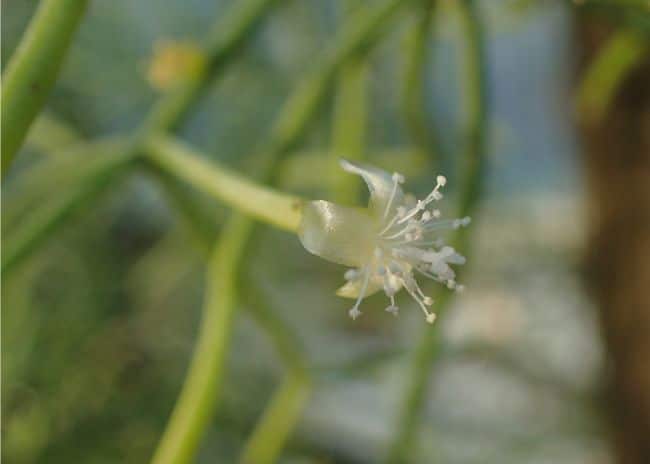
Why Are My Rhipsalis Stems Puckering?
If you notice the stems on your Mistletoe Cactus beginning to pucker you aren’t giving it enough water. Unlike the vast majority of cacti, Rhipsalis plants like regular water applications that keep the soil slightly moist.
During the growing season of spring through summer, water once the surface of the soil feels dry. In autumn and winter, allow the top 1-2 inches dry out before watering, as the plant will have lower water requirements at this time.
My Rhipsalis Stems Are Dropping Off The Plant
Dropping stems from your Mistletoe cactus means it’s being overwatered. Allow the soil to almost dry before you water again. Only water when the top of the soil starts to dry out.
If water seems to pool on top of the soil and not drain, make sure you are using well-draining potting mix and that the pot has plenty of drainage holes.
The Stems On My Mistletoe Cactus Are Black, Mushy And The Plant Is Dying
If sections of your Rhipsalis are turning black and mushy and it is starting to affect the entire plant, you have a root rot problem due to too wet conditions. Prune off any healthy stems that aren’t affected and repot into a rich potting mix that drains well. Discard the remainder of the plant as it’s dead and can’t be saved.
Is Rhipsalis Toxic To Humans And Pets?
Mistletoe Cactus plants are non-toxic to dogs, cats, horses and humans and in fact, the ripe berries are edible and sweet tasting.
Do Rhipsalis Plants Bloom?
Rhipsalis plants bloom periodically year-round, when grown in preferred conditions.
Why Is My Rhipsalis Turning Red?
The Mistletoe Cactus is receiving too much light if the stems turn red and should be placed where there is bright filtered light.

